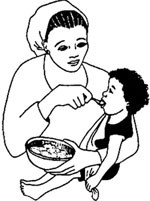11.3 Recommendations for infants from six to 12 months
You are now going to look at feeding and the range of foods appropriate for infants aged six‒12 months (see Table 11.2). As you will see, by six months, all children should have additional, nutritious food introduced into their diet, known as complementary foods.
| Six months up to 12 months | ||
|---|---|---|
|
| By six months of age, all children should be receiving a soft, nutritious complementary food. It is important to actively feed the child. Active feeding means encouraging the child to eat. The child should not have to compete with older brothers and sisters for food from a common plate. He should have his own serving. Until the child can feed himself, the mother or another caregiver (such as an older sibling, father or grandmother) should sit with the child during meals and help get the spoon into his mouth. An ‘adequate serving’ means that the child does not want any more food after active feeding. A good daily diet should be adequate in quantity and include an energy-rich food (for example, soft cereal-based porridge with added oil); meat, fish, eggs, or pulses; and fruits and vegetables. |
11.2.1 Advantages of breastmilk



